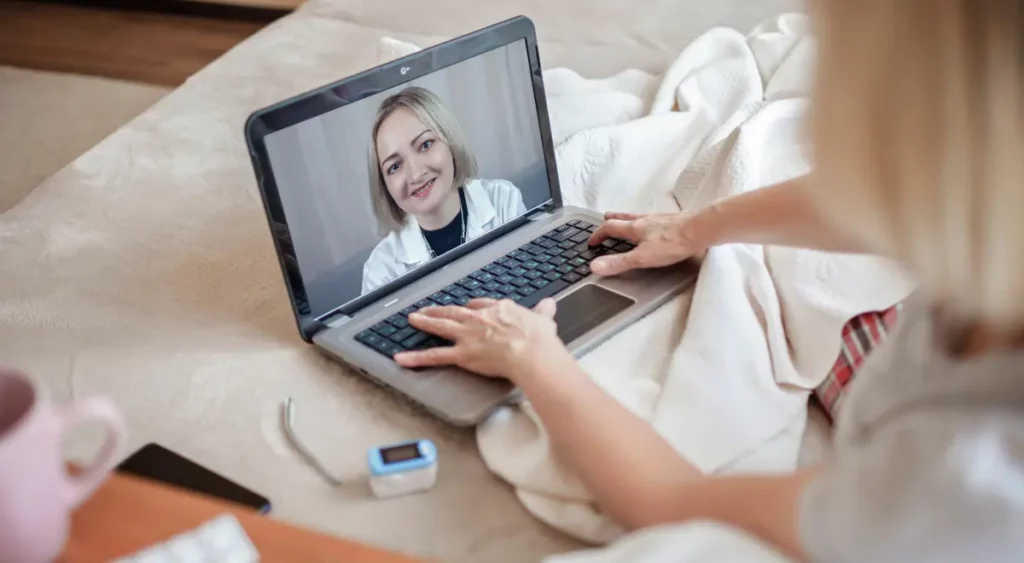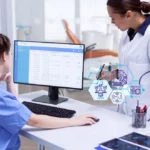How Remote Patient Monitoring (RPM) Reduces Hospital Readmissions?

Remote Patient Monitoring (RPM) became globally popular after the outbreak of Covid-19 pandemic. It offers many benefits for individuals with chronic health disorders that require regular checkup or monitoring by a healthcare professional. Also, it serves as a bridge between the patient and clinician by eliminating the communication barrier that often comes up with remote consultations.
RPM is quickly becoming a standard in the healthcare industry. It involves monitoring chronically ill patients by electronically evaluating their health data over cloud RPM software, formulating the right treatment plan and making timely interventions, resulting in reduced hospital admissions and readmissions.
RPM’s role in reducing readmissions is part of its broader impact—see our Remote Patient Monitoring Guide to explore how RPM supports proactive care, improves population health outcomes, and enables value-based healthcare delivery.
Table of Contents
ToggleRPM Adoption in the US Healthcare System
In the US, all leading hospitals and healthcare facilities are implementing RPM solutions to improve post-acute care, after hospital discharge care, and to optimize chronic care management to identify and avoid complicating the symptoms in patients. Even health insurance companies are adopting RPM programs to monitor and interact with high-risk patients who have active health insurance coverage.
A recent study on RPM popularity among healthcare professionals point out that nearly 88% of healthcare organizations are now investing in remote monitoring technology, while 68 percent of physicians strongly intended to use RPM in the future.
Remote patient monitoring is proven to improve patient engagement and health outcomes, while ensuring fewer readmissions and lower healthcare costs. It also strengthens care coordination with RPM by enabling seamless communication and collaboration between care teams, especially during post-discharge or chronic care follow-ups.
RPM is Focused on Reducing Hospital Readmissions
According to the Agency for Healthcare Research and Quality (AHRQ) report for hospital readmission rates, the current rate of readmission is as high as 14%, costing $15,200 on average per readmission. Hospital readmissions are quite expensive and affect almost everyone involved in the healthcare cycle, right from the patients to healthcare providers and payers.
With a focus on value-based care models, healthcare professionals are committed to reducing hospital readmissions as a part of remote patient monitoring program and aims to achieve it by improving patient outcomes and quality of care.
Top Ways Remote Patient Monitoring Reduces Hospital Readmissions
By reducing or eliminating the need for patients to visit their healthcare providers physically in a clinical setting, RPM can greatly reduce hospital readmissions. Some of the ways RPM is helping achieve this include:
- Identify & Monitor High-risk Patients
Healthcare providers usually know which of their patients are at a higher risk of readmission and can reduce that risk by providing a comprehensive virtual care plan. By asking their patients to record and report their health vitals everyday via Bluetooth or cellular medical devices, providers can make timely interventions and respond on clinical alerts with emergency.
- Automated Medication Reminders
Medication adherence plays a significant role in patients’ recovery and treatment outcomes. RPM allows healthcare providers to improve medication adherence among chronic patients by setting up medication alerts, reminders, and notifications.
- Enhanced Patient Engagement
When patients actively participate in their own care, they are more likely to adhere to and actively participate in their care and treatment plans. Most remote monitoring devices come with user-friendly features and ease of use that allows patients to record, track, and monitor their health data leading to enhanced patient engagement, better health outcomes, and fewer readmissions.
- Makes Timely Interventions
RPM helps healthcare providers in making timely interventions and informed decisions by monitoring real-time health data that provides insights on patient’s existing condition and vitals. In case, any of the body checks are higher or lower than they should be, an alert is quickly sent to the healthcare provider. This way, timely interventions can be made and emergency situation can be avoided.
- Improved Post-discharge Care
Majority of patients don’t understand the basics of post-discharge care and take the instructions given by the clinicians for granted. If not taken good care of, patients can often end up being hospitalized again. RPM allows healthcare providers to communicate with their patients regularly, along with tracking their post-discharge progress. This can help address complicated health issues and improve health outcomes. For patients with multiple chronic conditions, coordinated care becomes even more essential—explore how CCM integration with RPM helps streamline care delivery and improve patient outcomes across programs.
Proven RPM Devices That Reduce Hospital Readmissions
- Wearable Mobile Devices
Wearable devices, like smart watches allows patients to record their vitals, such as heart rate, pulse rate, sleep patterns, and more. This data is then transmitted over a cloud RPM platform from where healthcare providers can access the patient records and track their progress. Wearable devices are considered more effective for monitoring patient health data compared to traditional methods.
- Patch-based Sensors
Patch-based sensors are FDA-approved wearable sensors that gather eight types of biometric data, right from electrocardiogram to heart rate activity levels. These patches are connected to a patient’s smartphone that is further connected to a remote patient monitoring platform. Patch-based sensors play a significant role in reducing hospitalization costs and improving patient outcomes.
- Bluetooth & Cellular Devices
Both Bluetooth and cellular devices allow patients to record their vitals in a convenient way, with the only difference being that the Bluetooth devices operate and connect via Bluetooth frequency whereas cellular devices operate via cellular device connection. Blood pressure monitor, weight scale, glucometer, pulse oximeter are some of the common Bluetooth and cellular devices that help patients in collecting their vitals and reporting them to healthcare providers via Bluetooth or cellular network.
Regardless of the RPM solution you use for health data reporting, a HIPAA- compliant remote care platform will securely transmit this data to your healthcare provider or physician who can review and make timely interventions in the treatment plan, wherever and whenever necessary. With 24/7 monitoring, RPM helps clinicians in monitoring their patients in between clinic visits, identify uneven health trends in real time, and avoid hospitalizations to a great extent.
Best Practices For Implementing RPM To Reduce Hospitalizations
- Choose the Right Technology
Just like the scope of RPM, the technology, devices, and equipment used in remote patient monitoring is equally extensive. Depending on your healthcare practice, the treatments you offer, and current health scenario, you can opt for the most suitable RPM equipment that allows data analytics and integration capabilities.
- Train Healthcare Staff
To deliver efficiency and the right patient care, it’s important to keep your healthcare staff updated with the latest RPM technology. Make sure you train your staff on how to assess data and make informed decisions with regular training sessions on RPM advancements.
- Educate Patients
Not only do healthcare staff needs to be trained, but patient also needs to be educated on how to use RPM devices properly. Providing training and education materials on RPM can provide clear instructions and assistance to patients using any of the monitoring devices.
- Data Security and Privacy
With cloud based software and digital health platform, the foremost concern is maintaining data security, privacy, and compliance. Make sure the RPM platform and devices you choose are SOC2 and HIPAA compliant for secure data transmission and storage.
Reduce Hospital Readmissions With HealthArc’s RPM Platform
With 24/7 patient monitoring, health data collection, and automated alerts, care teams can proactively address any emergency health issues and prevent hospital readmissions, making healthcare model more efficient with a focus on value-based care.
HealthArc’s all-in-one advanced care management platform helps practices in connecting to their patients in a remote setting, without compromising the healthcare delivery. With our RPM software, optimize reimbursement and minimize documentation for increased clinical efficiency. Being HIPAA-compliant, we promise unmatched data security and privacy, along with adherence to reimbursement and billing policies.
Healthcare providers can now communicate with patients via audio calls, video calls, SMS, and make SDoH enabled care plans available. Monitor your patients 24/7, refill prescriptions, review diagnostics, and make referrals using HealthArc.
To find out how our digital health platform can help you reduce hospital readmissions and achieve your healthcare practice goals, schedule a free demo or give us a call at +201 885 5571.
Bibliography
Agency for Healthcare Research and Quality (AHRQ). (2022). Hospital Readmissions Reduction Program. Retrieved from https://www.ahrq.gov/topics/hospital-readmissions.html
American Medical Association (AMA). (2021). Remote Patient Monitoring: New Opportunities in the Healthcare Landscape.
Dinesen, B., Nonnecke, B., Lindeman, D., Toft, E., Kidholm, K., Jethwani, K., … & Nesbitt, T. (2016). Remote Patient Monitoring for Chronic Conditions: A Systematic Review. Journal of Medical Internet Research, 18(3), e75. doi:10.2196/jmir.5378 Retrieved from https://www.jmir.org/2016/3/e75/
Hoffman, J. T., McKenna, S. J., & McGrath, M. (2020). Remote Patient Monitoring and Reducing Readmissions: A Value-Based Care Approach. Healthcare Financial Management Journal, 74(9), 58-65.
Most Recent Blogs
Categories
Related Blog
- August 25, 2025 | Read Time: 13 mins
How Can “One Big Beautiful Bill” Boost RPM Programs by $50B?
The “One Big Beautiful Bill,” signed July 4, 2025, directs $50B over...
Learn More- August 22, 2025 | Read Time: 17 mins
HealthArc Platform vs RPM Software Solutions
Is your healthcare organization trying to pick a remote patient monitoring solution?...
Learn More- August 8, 2025 | Read Time: 17 mins
Remote Patient Monitoring ROI in 2026: Costs, Benefits & Is It Worth It?
With a giant sweep taking place in the digital transformation of at-home...
Learn More


